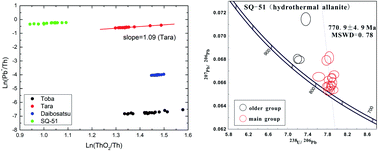当前位置:
X-MOL 学术
›
J. Anal. At. Spectrom.
›
论文详情
Our official English website, www.x-mol.net, welcomes your
feedback! (Note: you will need to create a separate account there.)
Allanite U–Th–Pb geochronology by ion microprobe
Journal of Analytical Atomic Spectrometry ( IF 3.1 ) Pub Date : 2020/01/07 , DOI: 10.1039/c9ja00426b Xin Liao 1, 2, 3, 4, 5 , Qiu-li Li 1, 2, 3, 4, 5 , M. J. Whitehouse 6, 7, 8 , Yue-heng Yang 1, 2, 3, 4, 9 , Yu Liu 1, 2, 3, 4, 9
Journal of Analytical Atomic Spectrometry ( IF 3.1 ) Pub Date : 2020/01/07 , DOI: 10.1039/c9ja00426b Xin Liao 1, 2, 3, 4, 5 , Qiu-li Li 1, 2, 3, 4, 5 , M. J. Whitehouse 6, 7, 8 , Yue-heng Yang 1, 2, 3, 4, 9 , Yu Liu 1, 2, 3, 4, 9
Affiliation

|
Allanite, an epidote group mineral, occurs as a common accessory mineral in igneous, metamorphic rocks and hydrothermal deposits. It contains radioactive elements Th and U, making it a valuable U–Th–Pb geochronometer for various geological processes. Due to the structural and compositional complexity of allanite, in situ dating method is a better choice when the allanite is heterogeneous or has crystallized in multi-stage events. The wide variation of chemical compositions, however, raises the potential for matrix effects and complicates the use of in situ methods for allanite U–Th–Pb chronology. To address this issue, we made a comprehensive investigation on allanite U–Th–Pb chronology using Secondary Ion Mass Spectrometry (SIMS). Five allanite samples (CAP, Daibosatsu, SQ-51, Toba OTT, TARA allanite) with variable elemental compositions and common lead concentrations have been used. Allanites with variations in FeO (from 12.8 to 16.1 wt%) and similar ThO2 contents (around 1–2%) do not show significant matrix effects, as suggested by a previous study. While, obvious changes in calibration parameters (UO2+/U+, ThO2+/Th+) were noticed for allanites with a large range of Th contents (from 300 ppm to 2.0 wt%). By employing power law relationships between Pb+/U+versus UO2+/U+, Pb+/Th+versus ThO2+/Th+ with suitable exponentials, we do not observe obvious matrix effects with ThO2 concentrations variations. This study demonstrates that allanite can be a good geochronometer for multi-stage mineralization of hydrothermal deposits, providing valuable complementary information to zircon and monazite.
中文翻译:

离子微探针对尿囊素U–Th–Pb的年代学
褐铁矿是一种显性的矿物,是火成岩,变质岩和热液矿床中常见的辅助矿物。它包含放射性元素Th和U,使其成为用于各种地质过程的有价值的U–Th–Pb地球计时器。由于尿囊石的结构和组成复杂性,当尿囊石是非均质的或在多阶段事件中结晶时,原位定年法是更好的选择。然而,化学成分的广泛变化增加了基质效应的可能性,并使原位使用变得复杂尿囊U–Th–Pb年表的方法。为了解决这个问题,我们使用二次离子质谱(SIMS)对尿囊素U-Th-Pb的年代进行了全面的研究。已使用了五种元素组成和共同铅含量可变的钙铝石样品(CAP,Daibosatsu,SQ-51,Toba OTT,TARA钙铝石)。如先前的研究表明,具有FeO变化(从12.8 wt%至16.1 wt%)和相似的ThO 2含量(大约1-2%)的尿囊石没有显示出明显的基质效应。同时,校准参数(UO 2 + / U +,ThO 2 + / Th +对于具有较大含量的Th含量(从300 ppm至2.0 wt%)的尿囊石,已注意到)。通过采用具有适当指数的Pb + / U +与UO 2 + / U +,Pb + / Th +与ThO 2 + / Th +之间的幂律关系,我们不会观察到ThO 2浓度变化带来的明显基质效应。这项研究表明,尿囊石可以作为热液矿床多阶段矿化的良好地球钟,为锆石和独居石提供有价值的补充信息。
更新日期:2020-03-12
中文翻译:

离子微探针对尿囊素U–Th–Pb的年代学
褐铁矿是一种显性的矿物,是火成岩,变质岩和热液矿床中常见的辅助矿物。它包含放射性元素Th和U,使其成为用于各种地质过程的有价值的U–Th–Pb地球计时器。由于尿囊石的结构和组成复杂性,当尿囊石是非均质的或在多阶段事件中结晶时,原位定年法是更好的选择。然而,化学成分的广泛变化增加了基质效应的可能性,并使原位使用变得复杂尿囊U–Th–Pb年表的方法。为了解决这个问题,我们使用二次离子质谱(SIMS)对尿囊素U-Th-Pb的年代进行了全面的研究。已使用了五种元素组成和共同铅含量可变的钙铝石样品(CAP,Daibosatsu,SQ-51,Toba OTT,TARA钙铝石)。如先前的研究表明,具有FeO变化(从12.8 wt%至16.1 wt%)和相似的ThO 2含量(大约1-2%)的尿囊石没有显示出明显的基质效应。同时,校准参数(UO 2 + / U +,ThO 2 + / Th +对于具有较大含量的Th含量(从300 ppm至2.0 wt%)的尿囊石,已注意到)。通过采用具有适当指数的Pb + / U +与UO 2 + / U +,Pb + / Th +与ThO 2 + / Th +之间的幂律关系,我们不会观察到ThO 2浓度变化带来的明显基质效应。这项研究表明,尿囊石可以作为热液矿床多阶段矿化的良好地球钟,为锆石和独居石提供有价值的补充信息。









































 京公网安备 11010802027423号
京公网安备 11010802027423号